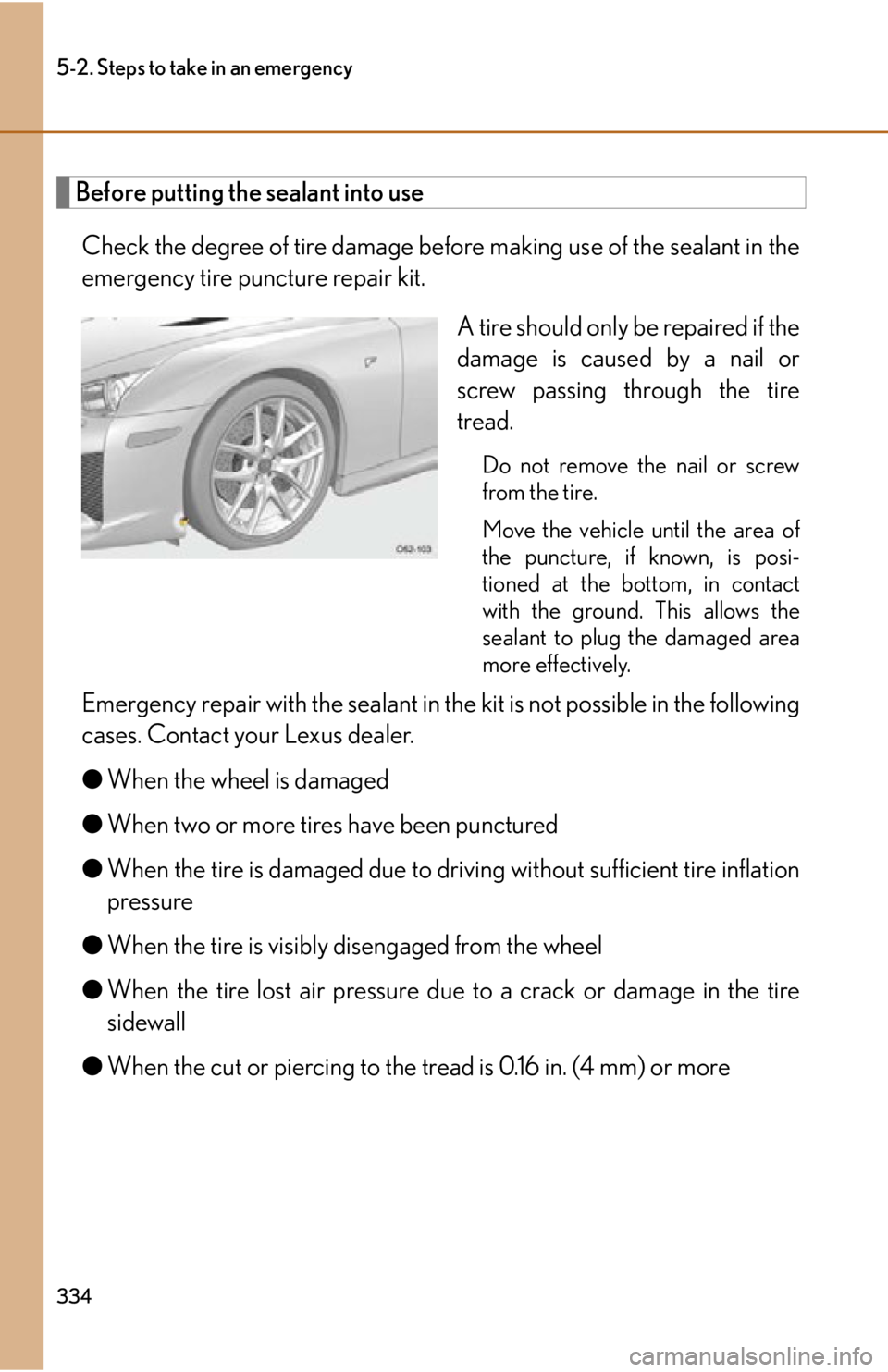Page 323 of 420
5
When trouble arises
321
5-2. Steps to take in an emergency
NOTICE
■Precaution when installing a different tire
When a tire of a different specification or maker is installed, the tire pressure warn-
ing system may not operate properly.
Page 336 of 420

334
5-2. Steps to take in an emergency
Before putting the sealant into useCheck the degree of tire damage befo re making use of the sealant in the
emergency tire puncture repair kit.
A tire should only be repaired if the
damage is caused by a nail or
screw passing through the tire
tread.
Do not remove the nail or screw
from the tire.
Move the vehicle until the area of
the puncture, if known, is posi-
tioned at the bottom, in contact
with the ground. This allows the
sealant to plug the damaged area
more effectively.
Emergency repair with the sealant in the kit is not possible in the following
cases. Contact your Lexus dealer.
● When the wheel is damaged
● When two or more tires have been punctured
● When the tire is damage d due to driving without sufficient tire inflation
pressure
● When the tire is visibly disengaged from the wheel
● When the tire lost air pressure due to a crack or damage in the tire
sidewall
● When the cut or piercing to the tread is 0.16 in. (4 mm) or more
Page 340 of 420
338
5-2. Steps to take in an emergency
Check the specified inflation pressure. (P. 366)
Turn the compressor switch “ON”
and fill the tire with air until the
specified inflation pressure is
reached.
Turn the switch “OFF” when the
pressure gauge connected to the
hose reads the specified pressure.
If the inflation pressure is not
attained within 8 minutes, emer-
gency repair is not possible due to
severe damage. Contact your
Lexus dealer.
After completely filling the tire with air, disconnect the hose from
the tire valve and the compress or power plug from the power
outlet.
To spread the liquid sealant ev enly in the tire, immediately drive
for about 3 miles (5 km) or 10 minutes.
Drive cautiously at a moderate speed, avoiding sudden starts, sudden
braking, and abrupt steering maneuvers.
After driving about 3 miles (5 km)
or 10 minutes, stop your vehicle in
a safe place and reconnect the
compressor.
STEP 14
STEP 15
STEP 16
STEP 17
STEP 18
STEP 19
Page 341 of 420
5
When trouble arises
339
5-2. Steps to take in an emergency
Read the inflation pressure on the
pressure gauge.
If the pressure is 18 psi (130 kPa,
1.3 kgf/cm
2 or bar) or above:
Fill the tire with air using the com-
pressor until the specified inflation
pressure is reached.
If the pressure is less than 18 psi
(130 kPa, 1.3 kgf/cm
2 or bar):
The emergency repair that has
been performed is not safe for use
as damage to the ti re is too severe.
Do not continue to drive the vehi-
cle. Contact your Lexus dealer.
Store the kit and then attach the
sticker as shown.
Taking precautions to avoid sud-
den braking and sharp turns, drive
carefully at under 50 mph (80
km/h) to the nearest Lexus dealer
or tire dealer for tire repair or
replacement.
STEP 20
STEP21
Page 342 of 420

340
5-2. Steps to take in an emergency
■Sealant
●One tire can be repaired using the bottle of sealant stored in the emergency tire
puncture repair kit.
●The sealant can be used when the outside temperature is from -22°F (-30°C)
to 140°F (60°C).
●When the outside temperature is low, the viscosity of the sealant becomes high
and it will be more difficult to inject th e sealant. In this case, warm the sealant in
the vehicle before using it.
●The sealant has a limited lifespan. The expi ration date is marked on the bottle.
The sealant should be replaced before the expiration date. Contact your Lexus
dealer.
●If the sealant gets on your clothes, it may stain.
●After using the sealant, bring the empty bottle of sealant to your Lexus dealer
and purchase a new bottle. Keep the ne w bottle of sealant in your vehicle.
■Compressor
●The compressor is a pneumatic filling type for passenger vehicles.
●When the compressor is operating, a loud operating noise will be produced.
This does not indicate a malfunction.
■The wheel of a tire that has been repaired
If you remove the sealant adhering to the wheel with a rag, you can reuse the wheel.
■The valve of a tire that has been repaired
●After a tire is repaired with the emergency tire puncture repair kit, the tire pres-
sure warning valve and transm itter should be replaced.
●After a tire is repaired with the emergency tire puncture repair kit, even if the
tire inflation pressure is at the recommended level, the tire pressure warning
light may come on/flash.
Page 344 of 420

342
5-2. Steps to take in an emergency
NOTICE
■Vehicles with a flat tire
Do not continue driving with a flat tire.
Driving even a short distance with a flat tire can damage the tire and the wheel
beyond repair.
■When performing an emergency repair
Perform the emergency repair without removing the nail or screw that has punc-
tured the tread of the tire. If the object th at has punctured the tire is removed, the
repair using the sealant in the emergenc y tire puncture repair kit may fail.
■When fixing the flat tire
●Do not put the valve core on dirty ground or in the sand.
Store it in a clean place.
●Do not remove the inside cap of the sealant bottle.
●Turn the valve core tool with your hand when screwing it in. If you use another tool
in conjunction with the valve core tool, damage may occur.
●Do not operate the compressor continuously for more than 10 minutes. The
motor may overheat and be damaged. Le t the compressor cool before using it
again.
■Compressor precautions
●The compressor power source should be 12 V DC suitable for vehicle use.
Do not connect the compressor to 24 V DC or any other power source.
●The compressor is an oil-less type. Do not lubricate with oil.
●If the compressor does not operate properly or becomes hot, it may be over-
heated. Turn off the switch and leave the compressor to cool down for at least 30
minutes.
●The compressor is not waterproof. Make sure that the compressor is not exposed
to water, such as when it is being used in the rain.
●Do not put the compressor directly onto dusty ground such as sand at the side of
the road. If the compressor vacuums up dust etc., a malfunction may occur.
●Do not disassemble or modify the compre ssor. Do not subject parts such as the
air pressure indicator to impacts. This may cause a malfunction.
Page 368 of 420
366
6-1. Specifications
Tires and wheels
Ti r e s i z e265/35ZR20 (95Y), 305/30ZR20 (99Y)
Front and rear tire inflation pres-
sure
(Recommended cold tire inflation
pressure) Front:
33 psi (230 kPa, 2.3 kgf/cm
2 or bar)
Rear: 33 psi (230 kPa, 2.3 kgf/cm
2 or bar)
Driving at high speeds (above 155 mph [250
km/h]) (in countries where such speeds are
permitted by law) Add 8 psi (50 kPa, 0.5 kgf/cm
2 or bar) to the
front tires and rear tires. Never exceed the
maximum cold tire inflation pressure indicated
on the tire sidewall.
Wheel size Front: 20
9 1 /2J
Rear: 20 11 1 /2J
Wheel bolt torque 81 ft•lbf (110 N•m, 11.2 kgf•m)
Page 373 of 420
371
6-1. Specifications
6
Vehicle specifications
Tire information
Ty p i c a l t i r e s y m b o l s
Ti r e s i z e( P. 3 7 3 )
TUBELESS or TUBE TYPE
A tubeless tire does not have a tube and air is directly put into the tire. A tube
type tire has a tube inside the tire and the tube maintains the air pressure.
Radial tires or bias-ply tires
A radial tire has “RADIAL” on the sidewall. A tire not marked “RADIAL” is a
bias-ply tire.
Uniform tire quality grading
For details, see “Uniform Tire Quality Grading” that follows.